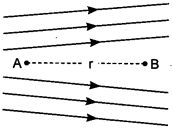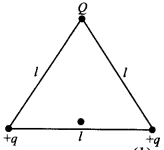Electrostatic Potential and Capacitance Class 12 Physics MCQs Pdf
11 v Figure shows the electric lines of force emerging from a charged body. If the
electric field at A and B are EA and EB respectively and if the displacement between
A and B is r then

(a) EA > EB
(b) EA < EB
(c) EA = EB/r
(d) EA = EB /r²
Answer/Explanation
Answer: a
Explaination: (a) In non-uniform electric field, intensity is more, where the
lines are more denser.
12. Which of the following options are correct? If a conductor has a potential V 4- 0
and there are no charges anywhere else outside, then [NCERT Exemplar]
(a) there must not be charges on the surface or inside itself.
(b) there cannot be any charge in the body of the conductor.
(c) there must be charges only on the surface.
(d) there must be charges inside the surface.
Answer/Explanation
Answer: b
Explaination:
(b) The charge resides on the outer surface of a closed charged conductor. Hence
there cannot be any charge in the body of the conductor. Hence option (b) is
correct.
13. Which of the following options is correct? In a region of constant potential
[NCERT Exemplar]
(a) the electric field is uniform.
(b) the electric field is zero.
(c) there can be charge inside the regiofi.
(d) the electric field shall necessarily change if a charge is placed outside the
region.
Answer/Explanation
Answer: b
Explaination:
(b) as E = \(\frac{-dV}{dr}\)
Since, V = constant, \(\frac{-dV}{dr}\) = 0 this implies that electric field
intensity E=0. If some charge is present inside the region then electric field
cannot be zero at that region, for this V=constant is not valid.
14. 64 drops each having the capacity C and potential V are combined to form a big
drop. If the charge on the small drop is q, then the charge on the big drop will
be
(a) 2q
(b) 4q
(c) 16q
(d) 64q
Answer/Explanation
Answer: d
Explaination: (d) By using Q = nq or Q = 6Aq
15. The radii of two metallic spheres A and B are r1 and r2
respectively (r1 > r2). They are connected by a thin wire
and the system is given a certain charge. The charge will be greater
(a) on the surface of the sphere B.
(b) on the surface of the sphere A.
(c) equal on both.
(d) zero on both.
Answer/Explanation
Answer: b
Explaination:
(b) After connection of wire, potential becomes equal, i.e,
Q1/r1 = Q2/r2 or
Q1/Q2 = r1/r2 when r1
> r2, then Q1 > Q2.
16. A parallel plate condenser is connected with the terminals of a battery. The
distance between the plates is 6mm. If a glass plate (dielectric constant K = 9) of
4.5 mm is introduced between them, then the capacity will become
(a) 2 times.
(b) the same.
(c) 3 times.
(d) 4 times.
Answer/Explanation
Answer:
Explaination:

17. Three charges Q, +q and +q are placed at the vertices of an equilateral triangle
of side l as shown in the figure. If the net electrostatic energy of the system is
zero, then Q is equal to

(a) -q
(b) +q
(c) zero
(d) –\(\frac{q}{2}\)
Answer/Explanation
Answer:
Explaination:

18. Two metal plates form a parallel plate capacitor. The distance between the plates
is d. A metal sheet of thickness \(\frac{d}{2}\) and of the same area is introduced
between the plates.
What is the ratio of the capacitance in the two cases?
(a) 2 : 1
(b) 3 : 1
(c) 2 : 1
(d) 5 : 1
Answer/Explanation
Answer:
Explaination:

19. Acapacitor of 4 pF is connected as shown in the circuit. The internal resistance
of the battery is 0.5 Q. The amount of charge on the capacitor plates will be [NCERT
Exemplar]

(a) 0
(b) 4
(c) 16 μC
(d) 8 μC
Answer/Explanation
Answer:
Explaination:
![]()
20. A capacitor is charged by using a battery which is then disconnected. A
dielectric slab
then slipped between the plates, which results in
(a) reduction of charge on the plates and increase of potential difference across
the plates.
(b) increase in the potential difference across the plate, reduction in stored
energy, but no change in the charge on the plates.
(c) decrease in the potential difference across the plates, reduction in the stored
energy, but no change in the charge on the plates.
(d) none of these
Answer/Explanation
Answer: c
Explaination:
(c) Battery in disconnected so Q will be constant. As
C ∝ K so with introduction of dielec-tric slab, the capacitance will increase
and using Q = CV, V will decrease.
Using U = \(\frac{Q²}{2C}\)